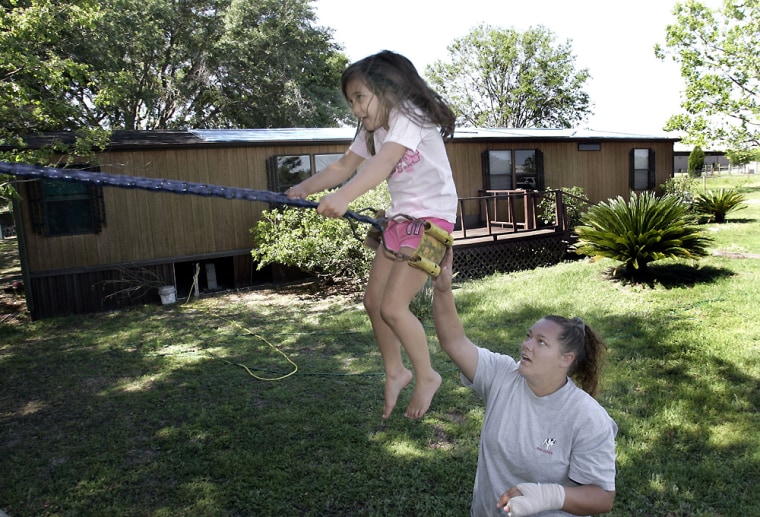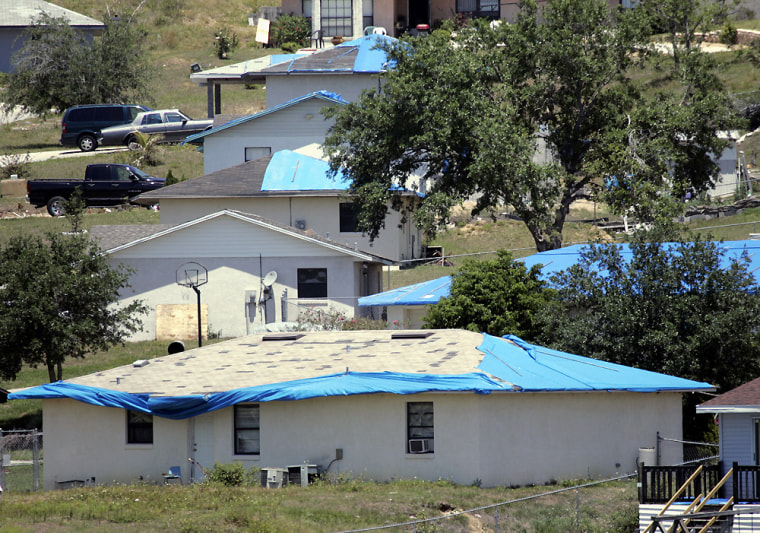Before last summer, Corrie Pope hardly gave a thought to preparing her rural mobile home for a catastrophic storm.
Being a good 60 miles inland from Florida’s west coast, she figured it would never be necessary. Then came hurricanes Charley, Frances and Jeanne, which crisscrossed in Pope’s tiny Alturas community south of Lake Wales in the space of six weeks in August and September, tearing up her family’s property, knocking out the power and splitting their doublewide at the center.
With a blue plastic tarp still covering her roof and a bare plywood floor still awaiting new carpet, Pope says she won’t be caught unaware when this year’s Atlantic hurricane season opens June 1. The house will be stocked with supplies.
“We’ve got tons and tons of candles and batteries,” says Pope, whose family finally received their insurance check last month to repair the damage. “I’ve got hurricane lamps. ... My dad is coming down to visit next month, and he’s bringing a generator and a chain saw.”
The four hurricanes that smacked Florida during an unprecedented and unforgettable 2004 season — “The Big 4 of ’04” — rattled the nerves and disrupted the lives of thousands of people, many of whom had dropped their guard after years of hearing about major hurricanes but never seeing one.
With forecasters expecting another active hurricane season — 13 named storms and seven hurricanes are predicted by Colorado State University forecasters — emergency management officials are hoping people have learned the same lessons as Pope and her family: Hardly anyone is safe, and when the storms come, be prepared.
No excuse for amnesia
“There should not be any more hurricane amnesia in Florida,” says Craig Fugate, the state’s director of emergency management. “One of the things we saw time and time again, businesses that were prepared did well and families that were prepared did well. Those that did not suffered.”

First Charley slammed Punta Gorda Aug. 13 and barreled northeast across the peninsula. Then Frances came ashore on Florida’s east coast near Stuart Sept. 5 and raced across the state before Ivan pummeled the Florida Panhandle and Gulf Coast states Sept. 16, collapsing part of Interstate 10. Finally, Jeanne hit Sept. 25, roughly following Frances’ path.
The storms were blamed for at least 130 deaths in the United States, mostly in Florida, and did an estimated $22 billion in insured wind damage. One in five Florida homes were damaged or destroyed. So far, insurers have paid more than 1.6 million claims from the storms.
Although the Federal Emergency Management Agency has paid out nearly $5 billion in assistance, many people are still trying to reclaim their lives as the new storm season rolls around.
29,000 still homeless
Debris is still being removed in places and blue FEMA tarps still cover damaged roofs as many residents await insurance checks or for one of the overburdened contractors to come do the repair work. About 29,000 displaced hurricane victims still occupy more than 11,000 mobile homes and travel trailers in temporary FEMA trailer parks.
“We’re better than we were, but we’re going to be another year, minimum,” says Lake Wales resident Joe Webb, who was overseeing repair work to the local Elks Lodge recently, delayed because of the shortage of licensed contractors.
Many people are still hurting, Webb says, and they’re apprehensive about what this summer might bring.
“When Charley came through, I said I don’t want to be here for another one,” Webb says. “And bam, here comes Frances and here comes Jeanne before I could even think straight. And the season’s coming, and I think you’ve got a lot of concerned people.”
Many deaths blamed on last year’s storms came afterward when people were trying to clean up and patch up their homes.
With forecasters saying there’s a 73 percent chance that at least one major hurricane will make landfall in the United States this season, no one should be caught napping.
“We have to prepare for the worst and hope for the best,” Fugate says.
Lessons learned
In Florida, the legacy of the storms will be the lessons learned by state emergency management officials. They worked this winter on new procedures to improve communication, get basic supplies into storm-damaged areas more quickly, and better define hurricane shelter plans and policies.
While FEMA received high praise during and immediately after the hurricanes, the agency is now facing questions from Congress on several issues and complaints from counties that say they’re facing financial burdens while waiting for FEMA checks.
Meanwhile, the agency is rethinking how and where it stores supplies before hurricanes and how it shelters people afterward. That includes expanding the use of clusters of temporary travel trailers to get hurricane refugees out of shelters sooner.
“The folks at FEMA are pumped up and they’re ready to go,” agency Director Michael Brown says. “They know they established a very high bar for themselves during the 2004 hurricane season.”
The storms prompted some other changes, too.
In Louisiana, memories of fearful evacuees stuck on highways for hours as Hurricane Ivan bore down spurred a revamped plan to move residents more quickly out of harm’s way. In Alabama, Gov. Bob Riley formed a task force to study insurance issues following months of complaints related to Hurricane Ivan recovery.
In North Carolina, Gov. Mike Easley recently signed into law a $247.5 million package that will assist homeowners, businesses and local governments still recovering from the effects of Ivan and Frances.
